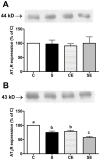Perinatal Na+ overload programs raised renal proximal Na+ transport and enalapril-sensitive alterations of Ang II signaling pathways during adulthood
- PMID: 22928034
- PMCID: PMC3425503
- DOI: 10.1371/journal.pone.0043791
Perinatal Na+ overload programs raised renal proximal Na+ transport and enalapril-sensitive alterations of Ang II signaling pathways during adulthood
Abstract
Background: High Na(+) intake is a reality in nowadays and is frequently accompanied by renal and cardiovascular alterations. In this study, renal mechanisms underlying perinatal Na(+) overload-programmed alterations in Na(+) transporters and the renin/angiotensin system (RAS) were investigated, together with effects of short-term treatment with enalapril in terms of reprogramming molecular alterations in kidney.
Methodology/principal findings: Male adult Wistar rats were obtained from dams maintained throughout pregnancy and lactation on a standard diet and drinking water (control) or 0.17 M NaCl (saline group). Enalapril (100 mg/l), an angiotensin converting enzyme inhibitor, was administered for three weeks after weaning. Ninety day old offspring from dams that drank saline presented with proximal tubules exhibiting increased (Na(+)+K(+))ATPase expression and activity. Ouabain-insensitive Na(+)-ATPase activity remained unchanged but its response to angiotensin II (Ang II) was lost. PKC, PKA, renal thiobarbituric acid reactive substances (TBARS), macrophage infiltration and collagen deposition markedly increased, and AT(2) receptor expression decreased while AT(1) expression was unaltered. Early treatment with enalapril reduced expression and activity of (Na(+)+K(+))ATPase, partially recovered the response of Na(+)-ATPase to Ang II, and reduced PKC and PKA activities independently of whether offspring were exposed to high perinatal Na(+) or not. In addition, treatment with enalapril per se reduced AT(2) receptor expression, and increased TBARS, macrophage infiltration and collagen deposition. The perinatally Na(+)-overloaded offspring presented high numbers of Ang II-positive cortical cells, and significantly lower circulating Ang I, indicating that programming/reprogramming impacted systemic and local RAS.
Conclusions/significance: Maternal Na(+) overload programmed alterations in renal Na(+) transporters and in its regulation, as well as severe structural lesions in adult offspring. Enalapril was beneficial predominantly through its influence on Na(+) pumping activities in adult offspring. However, side effects including down-regulation of PKA, PKC and AT(2) receptors and increased TBARS could impair renal function in later life.
Conflict of interest statement
Figures












Similar articles
-
Metabolic programming during lactation stimulates renal Na+ transport in the adult offspring due to an early impact on local angiotensin II pathways.PLoS One. 2011;6(7):e21232. doi: 10.1371/journal.pone.0021232. Epub 2011 Jul 1. PLoS One. 2011. PMID: 21747933 Free PMC article.
-
Renal molecular mechanisms underlying altered Na+ handling and genesis of hypertension during adulthood in prenatally undernourished rats.Br J Nutr. 2014 Jun 14;111(11):1932-44. doi: 10.1017/S0007114513004236. Epub 2014 Mar 24. Br J Nutr. 2014. PMID: 24661554
-
Placental oxidative stress in malnourished rats and changes in kidney proximal tubule sodium ATPases in offspring.Clin Exp Pharmacol Physiol. 2009 Dec;36(12):1157-63. doi: 10.1111/j.1440-1681.2009.05212.x. Epub 2009 May 19. Clin Exp Pharmacol Physiol. 2009. PMID: 19473191
-
The paradox of dopamine and angiotensin II-mediated Na(+), K(+)-ATPase regulation in renal proximal tubules.Clin Exp Hypertens. 2010;32(7):464-8. doi: 10.3109/10641963.2010.496516. Clin Exp Hypertens. 2010. PMID: 21029011 Review.
-
[Molecular mechanisms of nephro-protective action of enalapril in experimental chronic renal failure].Ann Acad Med Stetin. 1999;Suppl 52:1-93. Ann Acad Med Stetin. 1999. PMID: 10589103 Review. Polish.
Cited by
-
Impact of early-life diet on long-term renal health.Mol Cell Pediatr. 2020 Dec 3;7(1):17. doi: 10.1186/s40348-020-00109-1. Mol Cell Pediatr. 2020. PMID: 33269431 Free PMC article. Review.
-
The Effect of Perinatal Taurine on Adult Renal Function Does Not Appear to Be Mediated by Taurine's Inhibition of the Renin-Angiotensin System.Adv Exp Med Biol. 2015;803:665-77. doi: 10.1007/978-3-319-15126-7_53. Adv Exp Med Biol. 2015. PMID: 25833535 Free PMC article.
-
How the kidney is impacted by the perinatal maternal environment to develop hypertension.Biol Reprod. 2013 Dec 19;89(6):144. doi: 10.1095/biolreprod.113.111823. Print 2013 Dec. Biol Reprod. 2013. PMID: 24227755 Free PMC article. Review.
References
-
- Marin ECS, Balbi APC, Francescato HDC, Alves da Silva CG, Costa RS, et al. (2008) Renal structure and function evaluation of rats from dams that received increased sodium intake during pregnancy and lactation submitted or not to 5/6 nephrectomy. Renal Fail 30: 547–555. - PubMed
-
- Cardoso HD, Cabral EV, Vieira-Filho LD, Vieyra A, Paixão AD (2009) Fetal development and renal function in adult rats prenatally subjected to sodium overload. Pediatr Nephrol 4: 1959–1965. - PubMed
-
- Contreras RJ, Wong DL, Henderson R, Curtis KS, Smith JC (2000) High dietary NaCl early in development enhances mean arterial pressure of adult rats. Physiol Behav 71: 173–181. - PubMed
-
- da Silva AA, de Noronha IL, de Oliveira IB, Malheiros DM, Heimann JC (2003) Renin-angiotensin system function and blood pressure in adult rats after perinatal salt overload. Nutr Metab Cardiovasc Dis 13: 133–139. - PubMed
-
- Balbi AP, Costa RS, Coimbra TM (2004) Postnatal renal development of rats from mothers that received increased sodium intake. Pediatr Nephrol 19: 1212–1218. - PubMed
Publication types
MeSH terms
Substances
LinkOut - more resources
Full Text Sources
Research Materials
Miscellaneous

